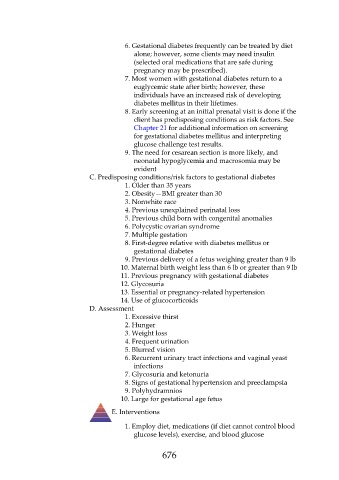Page 676 - Saunders Comprehensive Review For NCLEX-RN
P. 676
6. Gestational diabetes frequently can be treated by diet
alone; however, some clients may need insulin
(selected oral medications that are safe during
pregnancy may be prescribed).
7. Most women with gestational diabetes return to a
euglycemic state after birth; however, these
individuals have an increased risk of developing
diabetes mellitus in their lifetimes.
8. Early screening at an initial prenatal visit is done if the
client has predisposing conditions as risk factors. See
Chapter 21 for additional information on screening
for gestational diabetes mellitus and interpreting
glucose challenge test results.
9. The need for cesarean section is more likely, and
neonatal hypoglycemia and macrosomia may be
evident
C. Predisposing conditions/risk factors to gestational diabetes
1. Older than 35 years
2. Obesity—BMI greater than 30
3. Nonwhite race
4. Previous unexplained perinatal loss
5. Previous child born with congenital anomalies
6. Polycystic ovarian syndrome
7. Multiple gestation
8. First-degree relative with diabetes mellitus or
gestational diabetes
9. Previous delivery of a fetus weighing greater than 9 lb
10. Maternal birth weight less than 6 lb or greater than 9 lb
11. Previous pregnancy with gestational diabetes
12. Glycosuria
13. Essential or pregnancy-related hypertension
14. Use of glucocorticoids
D. Assessment
1. Excessive thirst
2. Hunger
3. Weight loss
4. Frequent urination
5. Blurred vision
6. Recurrent urinary tract infections and vaginal yeast
infections
7. Glycosuria and ketonuria
8. Signs of gestational hypertension and preeclampsia
9. Polyhydramnios
10. Large for gestational age fetus
E. Interventions
1. Employ diet, medications (if diet cannot control blood
glucose levels), exercise, and blood glucose
676

